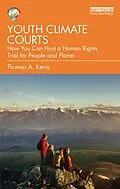This book focuses on Youth Climate Courts, a bold new tool that young people in their teens and twenties can use to compel their local city or county government to live up to its human rights obligations, formally acknowledge the climate crisis, and take major steps to address it.
Tom Kerns shows how youth climate leaders can form their own local Youth Climate Court, with youth judges, youth prosecuting attorneys, and youth jury members, and put their local city or county government on trial for not meeting its human rights obligations. Kerns describes how a Youth Climate Court works, how to start one, what human rights are, what they require of local governments, and what governmental changes a Youth Climate Court can realistically hope to accomplish. The book offers young activists a brand new, user-friendly, cost-free, barrier-free, powerful tool for forcing local governments to come to terms with their obligation to protect the rights of their citizens with respect to the climate crisis.
This book offers a unique new tool to young climate activists hungry for genuinely effective ways to directly move governments to aggressively address the climate crisis.
Autorentext
Tom Kerns is Director of Environment and Human Rights Advisory and Professor Emeritus of Philosophy at North Seattle College, USA. His work brings human rights norms to bear on environmental issues, especially on the climate crisis. In 2015 he served on the drafting group for the international "Declaration on Human Rights and Climate Change", and from 2014 until 2018 he co-organized the 2018 Permanent Peoples' Tribunal Session on Human Rights, Fracking and Climate Change. He is co-editor, with Kathleen Dean Moore, of Bearing Witness: The Human Rights Case Against Fracking and Climate Change (2021), a book based on the testimony and findings in that Tribunal.
Inhalt
Acknowledgments
Dear Reader
Introduction
Premises
The plight of the young
Brief overview of Youth Climate Courts
Purposes of Youth Climate Courts
How to read this book
Chapter 1: How Does a Youth Climate Court Work?
Why conduct a Youth Climate Court?
Whom should Youth Courts put on trial?
Roles on the Youth Climate Court team
The youth judge
The question to be decided
The youth prosecuting team
The youth liaison for the government representative to the court
Youth jury members
Media organizer (for news reporters, bloggers, social media, etc)
Video-recording organizer
Adult advisor or mentor?
But will governments even show up?
Youth Climate Courts' teeth
The prosecutor's argument
The verdict
If not guilty
If guilty, the court's mandate
Issuing a mandate
Mandate options
- Restorative justice process
- Climate Emergency and Climate Action Plan
- Climate-in-all-policies rule
- Climate Action Plan with climate-in-all-policies included
- Endorse Declaration on Human Rights and Climate Change
- Add climate language or amendment to founding document
- Divest city or county investments from fossil fuel corporations
- Artistic installations
- Any combination of the above
- The Declaration on Human Rights and Climate Change
- The Restorative Justice Only Option
- A Note on Rights of Nature
- Measures that local governments should consider including in their Climate Action Plans
- Potential risks to youth organizers?
Climate emergency declarations
Climate Action Plans
International Coalition of Youth Courts
Basic steps in the process of developing a Youth Climate Court
Adaptable, flexible, malleable, innovative
Chapter 2: What Are Human Rights?
What are human rights?
Modern history of human rights
Human rights as moral and legal standards
Why human rights?
The purpose of governments
Human rights obligations of governments
Tools available in human rights advocacy
Telling the story
Claiming moral authority with Human Rights Assessments, reports, Tribunal and Inquiry findings
Exercising moral power: Inquiries, Tribunals, Youth Climate Courts
The power of the moral
Chapter 3: Which Specific Human Rights?
Environmental Justice
Right to life
Right to health
Right to an adequate standard of living
Right to food
Right to water and sanitation
Rights of the child
Rights of vulnerable populations
The Right of Indigenous Peoples to Own, Use, Develop, and Control Traditional Lands and Water
Right to a healthy environment
Human Rights documents
Coda: Youth interventions for an addicted world
Appendices
